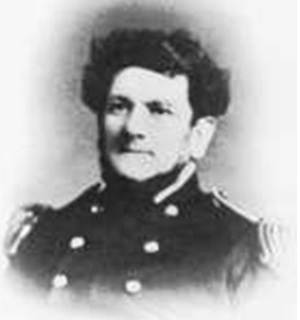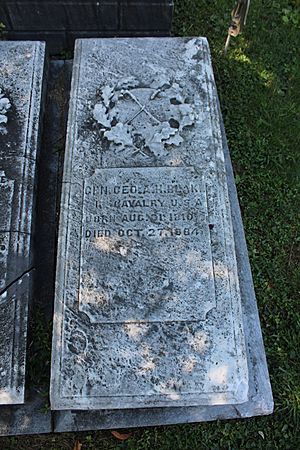George A.H. Blake facts for kids
Quick facts for kids
George Alexander Hamilton Blake
|
|
|---|---|

George A.H. Blake
|
|
| Born | August 31, 1810 Philadelphia, Pennsylvania |
| Died | October 27, 1884 (aged 74) Washington, D.C. |
| Buried | |
| Allegiance | United States Union |
| Service/ |
United States Army Union Army |
| Years of service | 1836-1870 |
| Rank | |
| Unit | 2nd U.S. Dragoons 1st U.S. Dragoons |
| Commands held | 1st U.S. Cavalry 2nd Brigade, Cavalry Reserve |
| Battles/wars | Second Seminole War |
| Relations | George E. Blake (father) George A. Blake (son) |
George Alexander Hamilton Blake (August 31, 1810 – October 27, 1884) was an important officer in the United States Army. He served as a cavalry officer during the American Indian Wars, the Mexican–American War, and the American Civil War. Blake was known for his bravery and leadership throughout his long military career.
Contents
Early Military Career
George Blake was born in Philadelphia, Pennsylvania, on August 31, 1810. His father, George E. Blake, was a musician. In 1836, when the 2nd U.S. Regiment of Dragoons was formed, Blake joined the army. He was given the rank of First Lieutenant.
Blake was sent to Florida and took part in the Second Seminole War. This war was fought between the United States and the Seminole Native Americans. He was involved in battles like the one at Fort Mellon and the Battle of Loxahatchee. In 1839, Blake was promoted to Captain. He continued serving in Florida until 1841. After that, his unit moved to Texas. In 1842, Captain Blake was put in charge of Fort Washita in Durant, Oklahoma.
Service in the Mexican–American War
In 1846, Captain Blake's regiment joined the Mexican–American War. They were part of the Brigade of Dragoons, a group of cavalry soldiers. Blake and his regiment fought in many important battles. These included the Battle of Cerro Gordo, Battle of Puebla, Battle of Contreras, Battle of Molino del Rey, and Battle of Chapultepec. They also took part in the final Battle for Mexico City.
After the war, Blake was praised by his commanders for his brave actions. He received a special promotion, called a brevet promotion, to Major. This was for his "gallant and meritorious conduct" during the war.
Life on the Western Frontier
After the Mexican-American War, Blake was transferred to the 1st U.S. Dragoons. He was promoted to full Major on July 23, 1850. His new assignment was on the Western Frontier. He helped establish Fort Massachusetts in the New Mexico Territory. This became the first permanent U.S. military post in what is now Colorado.
By 1854, Major Blake was in command of Fort Burgwin. He was involved in actions against the Jicarilla Apache people in the area. He even worked with the famous explorer Kit Carson on a scouting mission. In 1857, Blake commanded a group of dragoons that went with Lieutenant Edward Fitzgerald Beale. They were part of the United States Camel Corps on an expedition in Arizona.
Role in the American Civil War
As the American Civil War began, George Blake continued to rise in rank. On May 3, 1861, he was promoted to Lieutenant Colonel. He then led a military expedition to the west coast. Early in 1862, he was called back to the East Coast. On February 13, 1862, he became a Colonel, leading his own regiment.
His regiment became part of the cavalry reserve for the Army of the Potomac. This was a major Union army. In March, Colonel Blake was given command of the 2nd Cavalry Brigade. He led this brigade during the Peninsula Campaign. He was wounded on June 27 during the Battle of Gaines's Mill.
Later War Service
In 1863, Major General Alfred Pleasonton took command of the cavalry. Pleasonton was an old friend of Blake's from their time in the 2nd Dragoons and the Mexican War. He brought Blake onto his staff as his Chief Mustering Officer. After the Gettysburg Campaign, where Blake fought with his regiment, he moved to an administrative role. He served in the Cavalry Bureau, managing supplies and special duties for the rest of the war.
On March 13, 1865, Blake received another brevet promotion. He was made a Brevet Brigadier General for his "gallant and efficient services during the Gettysburg Campaign." On the same day, he was also brevetted Major General for his "meritorious services during the war." This second promotion was officially confirmed in 1869.
Later Life and Retirement

After the Civil War ended, Blake remained in the army. He continued to command the 1st Cavalry. He also commanded Fort Vancouver in the Oregon Territory (which is now part of Washington state). He retired from the army on December 15, 1870.
After retiring, George Blake moved to Washington, D.C.. He lived there until his death in 1884. He was buried in Laurel Hill Cemetery in Philadelphia, Pennsylvania.

